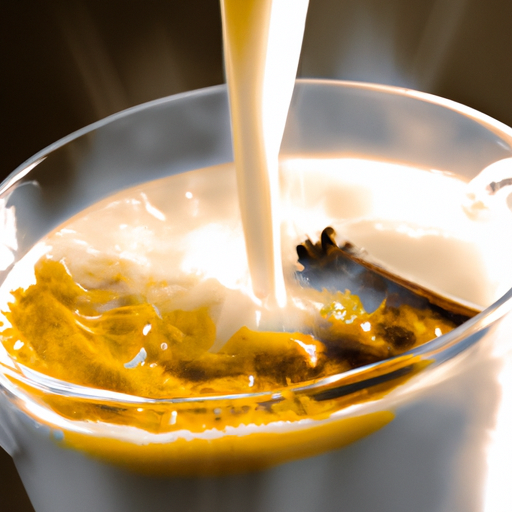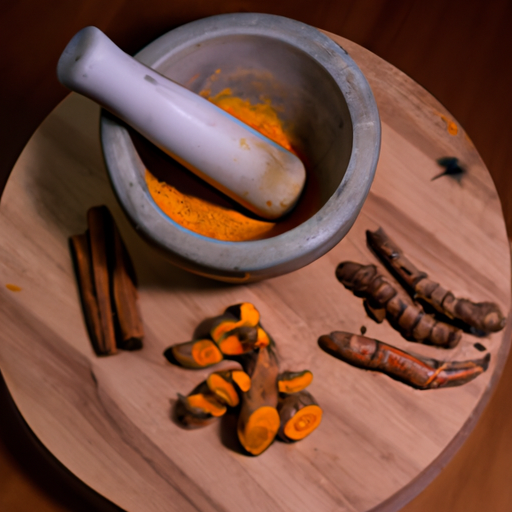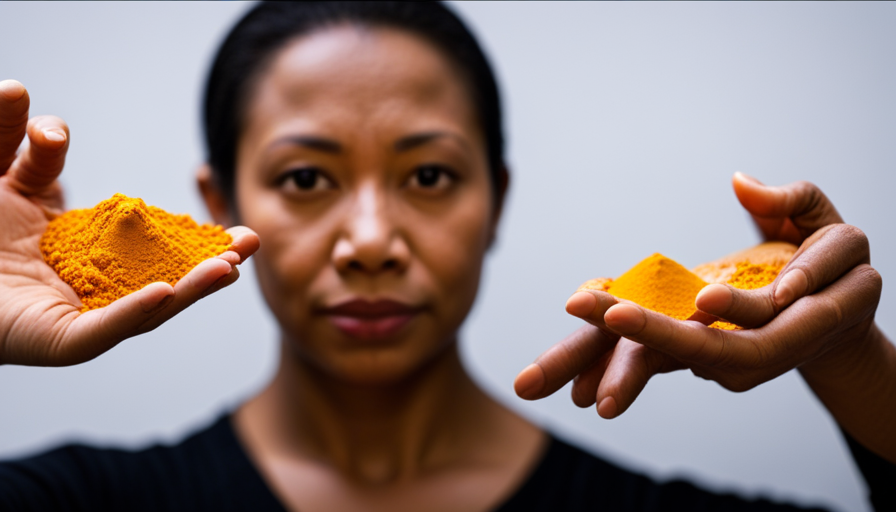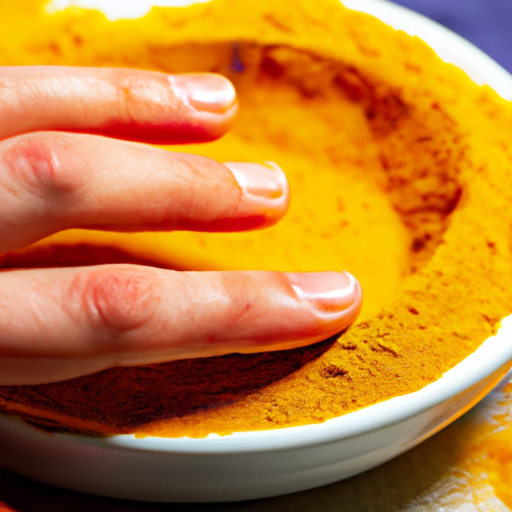Do you enjoy turmeric tea? This cozy and flavorful drink has become increasingly popular for its many health advantages in recent years.
One common question that many people have is whether or not it is okay to add milk to their turmeric tea. In this article, we will explore the science behind the absorption of curcumin, the active ingredient in turmeric, and whether or not adding milk can enhance its benefits.
Turmeric tea has been used for centuries in Ayurvedic medicine to treat a variety of ailments, including inflammation, digestive issues, and even depression. The main active ingredient in turmeric, curcumin, has been shown to have powerful anti-inflammatory and antioxidant properties. However, curcumin is not easily absorbed by the body on its own.
This has led some people to wonder if adding milk, which contains fat, can help increase the absorption of curcumin and thus enhance the health benefits of turmeric tea. So, can you put milk in turmeric tea? Let’s find out.
Key Takeaways
- Adding milk to turmeric tea is a personal preference and can be a debated topic due to the belief that milk proteins can bind to curcumin, reducing its absorption.
- Some studies suggest that adding milk to turmeric tea can increase curcumin absorption, especially if the milk is low in fat, but precautions should be taken when adding milk to turmeric tea, such as using the right amount of turmeric and considering other options like honey or ginger.
- Milk can cause digestive issues for some people who are lactose intolerant, and can cause an allergic reaction in people with milk allergy when added to turmeric tea.
- Vegan alternatives to milk include almond milk, coconut milk, oat milk, and soy milk, which can be used as a dairy-free alternative to enhance the flavor and health benefits of turmeric tea.
The Health Benefits of Turmeric Tea
You’ll be amazed at how much your health can benefit from drinking turmeric tea regularly, so go ahead and try adding a splash of milk to it for an even more enjoyable and nutritious experience.
Turmeric tea is a traditional Indian drink that has been used for centuries to treat a variety of ailments. The spice, turmeric, contains curcumin which has anti-inflammatory and antioxidant properties that can boost your immune system, reduce inflammation, and even improve brain function.
To make the perfect cup of turmeric tea, start by boiling water in a pot and adding in a teaspoon of ground turmeric. Let it simmer for about 10 minutes, then strain the mixture through a fine mesh strainer and serve it hot. You can also add honey or lemon to taste, depending on your preference.
The history of turmeric tea is long and rich, and its health benefits have been recognized for centuries. Now, let’s explore how adding milk to turmeric tea can enhance its flavor and nutritional value.
Adding Milk to Turmeric Tea
If you’re wondering whether or not to add milk to your turmeric tea, there are a few things to consider.
One of the main debates is how well curcumin (the active ingredient in turmeric) is absorbed by the body. Some studies suggest that adding black pepper can enhance absorption, while others argue that the fat in milk can also help.
However, it’s important to note that adding milk to your turmeric tea can also come with some drawbacks, such as the potential for added calories and the possibility of interfering with the tea’s natural health benefits.
The Debate on Curcumin Absorption
To maximize the benefits of turmeric tea, adding a small amount of black pepper can enhance the absorption of curcumin into your bloodstream. Curcumin bioavailability is a critical factor in the debate on whether or not to add milk to turmeric tea.
The milk controversy surrounding turmeric tea has been fueled by the belief that milk proteins can bind to curcumin, reducing its absorption. However, some studies suggest that adding milk to turmeric tea can increase curcumin absorption, especially if the milk is low in fat.
The benefits of milk in turmeric tea are still up for debate, but adding a small amount of milk may help enhance curcumin absorption. Milk proteins can bind to curcumin, but the addition of black pepper and low-fat milk may help increase bioavailability.
The Benefits of Milk
When adding a creamy, white liquid to your turmeric tea, the benefits of milk may surprise you. Contrary to popular belief, milk can actually aid in weight loss due to its high protein content. Protein helps to keep you feeling full for longer periods of time, which can prevent overeating and ultimately lead to weight loss.
Additionally, while milk has been touted as a key ingredient for maintaining strong bones, recent studies have debunked this myth. While calcium is important for bone health, milk is not the only source of this nutrient. In fact, some studies suggest that consuming too much milk can actually increase the risk of fractures.
Despite this, milk still has many benefits and can be a great addition to your turmeric tea. As we move on to discussing the drawbacks of milk, it’s important to note that while it may not be the end-all-be-all for bone health, it still has many other benefits that make it a valuable addition to your diet.
The Drawbacks of Milk
Did you know that despite its benefits, milk can actually cause digestive issues for some people? In fact, up to 65% of the world’s population has some form of lactose intolerance, which can lead to bloating, gas, and diarrhea after consuming dairy products. This can be a major drawback for those who enjoy drinking milk or adding it to their tea.
If you’re one of the many people who experience these symptoms, it may be time to consider alternatives to milk. Fortunately, there are plenty of vegan options that can be used in place of milk. Some popular alternatives include almond milk, coconut milk, oat milk, and soy milk. These options are not only lactose-free but also provide unique flavors and nutritional benefits.
So, if you’re looking to avoid the drawbacks of milk, try experimenting with these vegan options in your turmeric tea.
Now, let’s talk about the science behind curcumin absorption.
The Science Behind Curcumin Absorption
Curcumin, the active ingredient in turmeric, is notoriously difficult for the body to absorb. This is due to its low bioavailability, which means that the body has a hard time absorbing and utilizing it. One of the main reasons for this is that curcumin is rapidly metabolized in the liver and intestinal wall, which limits its absorption into the bloodstream. Additionally, curcumin is also known to bind to milk proteins, which can further reduce its bioavailability.
To better understand the science behind curcumin absorption, take a look at the table below. It shows the different factors that can affect curcumin bioavailability, including the use of milk and other substances. As you can see, consuming curcumin with black pepper can significantly increase its absorption, while consuming it with milk can decrease it. This is because black pepper contains piperine, a compound that can enhance curcumin absorption, while milk proteins can bind to curcumin and reduce its bioavailability.
If you’re looking for alternative ways to enjoy turmeric tea, there are plenty of options available. You can try adding black pepper or ginger to your tea, as these ingredients can enhance curcumin absorption. You can also try using a curcumin supplement, which can provide a more concentrated dose of curcumin that is easier for the body to absorb. Whatever method you choose, be sure to consult with your healthcare provider to ensure that it is safe and appropriate for your individual needs.
Alternative Ways to Enjoy Turmeric Tea
If you want to try alternative ways to enjoy turmeric tea, there are a few options that you might find interesting.
One option is to add honey and lemon to your turmeric tea, which can help enhance the flavor and add some sweetness.
Another option is to add ginger, which can give your tea a spicy kick and provide additional health benefits.
Finally, you could try making a turmeric latte, which combines turmeric with milk and other spices for a warm and comforting drink.
Adding Honey and Lemon
You can enhance the flavor of your turmeric tea by adding a spoonful of honey and a squeeze of lemon. For example, imagine sipping on a warm cup of turmeric tea with a touch of sweetness from honey and a refreshing tang from lemon, perfect for a cozy evening in.
Here are three reasons why adding honey and lemon is a great way to enjoy your turmeric tea:
-
Honey variations: Honey comes in different flavors such as clover, acacia, and wildflower, and each of them can enhance the taste of your turmeric tea in various ways. For instance, clover honey is mild and sweet, while acacia honey has a subtle floral flavor. Experiment with different types of honey to find the one that suits your taste buds.
-
Best milk alternatives: If you’re looking for a dairy-free option, adding honey and lemon to your turmeric tea is a great alternative to milk. Honey adds sweetness, and lemon brings a zesty flavor, making it a perfect dairy-free substitute.
-
Health benefits: Honey has natural antibacterial properties, while lemon is rich in vitamin C. Adding them to your turmeric tea can boost your immune system and improve digestion.
Adding ginger to your turmeric tea can add a spicy kick to your drink. So, if you want to add a little bit of heat to your turmeric tea, continue reading about adding ginger in the next section.
Adding Ginger
Now that you know how honey and lemon can enhance the flavor of your turmeric tea, let’s explore another ingredient that can give your drink an extra kick. Adding ginger to your turmeric tea not only adds flavor but also provides a host of health benefits.
Ginger has anti-inflammatory properties that can help alleviate joint pain and reduce muscle soreness. It can also aid in digestion and boost your immune system. If you’re not a fan of ginger, don’t worry. There are plenty of alternatives to choose from.
You can try adding cinnamon, cardamom, or black pepper to your turmeric tea for a different flavor profile. These spices also have their own set of health benefits that can complement the effects of turmeric. As you continue to experiment with different ingredients in your turmeric tea, you may find that you prefer a creamier texture.
In the next section, we’ll explore how to turn your turmeric tea into a latte using milk or a milk alternative.
Making a Turmeric Latte
Transforming your turmeric beverage into a creamy latte is a simple way to elevate the flavor and texture of your drink while also incorporating more health benefits.
To make a turmeric latte, start by heating up your milk in a small saucepan over low-medium heat. Once the milk is hot, add a teaspoon of turmeric powder and stir until fully combined.
To take your turmeric latte to the next level, try experimenting with different milk alternatives such as almond, coconut, or oat milk. Frothing your milk can also add a luxurious texture to your drink. To froth your milk, use a handheld frother or a milk frother machine.
Simply heat up your milk and then froth it until it becomes light and airy. As you begin to explore the world of turmeric lattes, keep in mind that there are endless ways to customize your drink to your liking.
In the next section, we’ll delve into some delicious recipes for turmeric tea that you can try at home.
Recipes for Turmeric Tea
Adding milk to turmeric tea is a common practice in many traditional Indian recipes. Turmeric tea variations can be made with spices like cinnamon, ginger, and black pepper, which are believed to enhance the health benefits of turmeric.
To make turmeric tea, you can start by brewing turmeric powder or fresh turmeric root in hot water for about 10 minutes. After brewing, you can add a splash of milk, a teaspoon of honey, or a pinch of cinnamon to your turmeric tea for added flavor. Some people also like to blend their turmeric tea with coconut oil or ghee for a creamy texture.
Brewing techniques for turmeric tea may vary depending on personal preference, but the addition of milk is a popular choice for those who prefer a creamy and decadent cup of tea. To prepare a perfect cup of turmeric tea, there are a few tips you can follow.
For example, make sure to use high-quality turmeric powder or fresh turmeric root for optimal flavor and health benefits. You can also experiment with different spices and sweeteners to create your own unique blend of turmeric tea.
With these tips in mind, you can enjoy a delicious and nourishing cup of turmeric tea that is both easy to make and good for you.
Tips for Preparing Turmeric Tea
For a perfect cup of turmeric tea, it’s important to use high-quality ingredients like fresh turmeric root or powder. Using fresh turmeric root adds a subtle earthy flavor to the tea that enhances its taste and aroma. Benefits of using fresh turmeric include a higher concentration of curcumin, the active compound in turmeric that provides its anti-inflammatory properties.
Another tip for preparing turmeric tea is to choose the best time of day to drink it. Although turmeric tea can be consumed at any time, it’s recommended to drink it in the morning or at night. Drinking turmeric tea in the morning can help boost your energy levels and improve your mood, while drinking it at night can promote relaxation and aid in digestion. Remember to add a pinch of black pepper to your turmeric tea, as this helps your body absorb curcumin more effectively.
Transitioning into the next section about potential side effects of turmeric tea, it’s important to note that while turmeric has many benefits, it can also have some adverse effects if consumed in excessive amounts.
Potential Side Effects of Turmeric Tea
When consuming turmeric tea, it’s important to be aware of potential side effects that may occur. If you’re taking any medications, it’s best to consult with your healthcare provider before adding turmeric tea to your routine, as it may interact with certain medications.
Additionally, some individuals may experience stomach upset or allergic reactions, so it’s important to pay attention to your body’s reactions and adjust accordingly.
Interactions with Medications
Turmeric tea may not be suitable for individuals taking certain medications due to potential interactions. It’s important to consult with your healthcare provider before consuming turmeric tea if you’re taking any prescription medication. Turmeric can interact with medications such as blood thinners, diabetes medication, and stomach acid reducers, which can either increase or decrease the effects of these medications.
To prepare turmeric tea for maximum health benefits, it’s recommended to mix 1-2 teaspoons of ground turmeric with hot water and add a dash of black pepper. The black pepper helps to increase the absorption of the turmeric in the body. You can also add other ingredients such as honey, ginger, or lemon to enhance the flavor and add additional health benefits.
While turmeric tea can offer numerous health benefits, it’s important to be mindful of any potential interactions with medications and to consult with your healthcare provider before adding it to your routine. If you experience stomach upset after drinking turmeric tea, there are steps you can take to alleviate discomfort.
Stomach Upset
Feeling a bit queasy after drinking turmeric tea? Don’t worry, stomach upset is a common side effect that can occur when consuming turmeric, especially on an empty stomach. Fortunately, there are simple remedies to reduce discomfort.
Firstly, try adding a small amount of black pepper to your turmeric tea. Black pepper contains a compound called piperine that enhances the bioavailability of curcumin, the active ingredient in turmeric. This can help improve digestion and alleviate stomach upset.
Additionally, ginger has been shown to have anti-inflammatory properties and can also aid in digestion. Consider adding a slice of fresh ginger to your turmeric tea or drinking ginger tea alongside it.
Transitioning into the subsequent section about allergic reactions, it’s important to note that while turmeric is generally safe for consumption, some people may experience allergic reactions. If you experience symptoms such as hives, itching, or difficulty breathing after consuming turmeric, stop consuming it immediately and seek medical attention.
Allergic Reactions
If you’re experiencing symptoms like hives or difficulty breathing after consuming turmeric, it’s important to seek medical attention immediately as you may be having an allergic reaction.
While turmeric is generally considered safe for consumption, some people may experience an allergic reaction due to cross reactivity concerns with other foods. It’s important to note that turmeric allergy is rare, but if you are allergic to ginger, cardamom, or other plants from the Zingiberaceae family, you may be more likely to develop an allergy to turmeric.
If you are allergic to milk, you may be wondering if it’s safe to add milk to your turmeric tea. While milk is not traditionally added to turmeric tea, it can be a delicious addition. However, if you have a milk allergy, it’s important to note that adding milk to your turmeric tea can cause an allergic reaction.
Instead, consider alternative milk options like almond milk, coconut milk, or soy milk to add creaminess to your turmeric tea.
As we move into the next section, let’s discuss some precautions to take when adding milk to your turmeric tea.
Precautions When Adding Milk to Turmeric Tea
Before you start adding milk to your turmeric tea, there are a few precautions you should keep in mind. Firstly, while milk can enhance the flavor of turmeric tea, it can also reduce its effectiveness.
Secondly, there are many other ways to enjoy turmeric tea, such as adding honey or ginger. Finally, the amount of turmeric you use in your tea is crucial, and it’s recommended to use around 1-2 teaspoons per cup.
Additionally, some studies suggest that turmeric tea may help with arthritis, but it’s important to consult with your doctor before using it as a treatment.
The Pros and Cons of Adding Milk to Turmeric Tea
Adding milk to your turmeric tea can change the flavor and texture, so it’s important to consider the pros and cons. On the one hand, adding milk can help mellow out the bitterness of turmeric and add a creamy texture to the tea. This might be particularly appealing to those who prefer their tea on the sweeter side or who enjoy the taste of milk in their beverages.
However, there are also some potential drawbacks to consider. For one, adding milk can dilute the potency of the turmeric, which means that you may not be getting as much of the health benefits as you would if you drank the tea without milk. Additionally, some people may not enjoy the taste of turmeric when combined with milk, which could be a dealbreaker for those who are sensitive to flavor. Ultimately, whether or not you choose to add milk to your turmeric tea will depend on your personal texture preference and taste profile.
When it comes to enjoying turmeric tea, there are many other ways to mix up your routine. Consider adding a squeeze of lemon or honey for added flavor, or experiment with different types of tea leaves to create unique blends. By exploring the many options available, you can discover the perfect way to enjoy all the benefits of turmeric in a way that suits your individual taste preferences.
Other Ways to Enjoy Turmeric Tea
Exploring various blends with different types of tea leaves and incorporating additional flavors like honey or lemon can provide diverse options for enjoying the benefits of turmeric tea. Spice combinations can also be added to the mix to create unique flavors and aromas. For example, combining turmeric tea with cinnamon, ginger, or cardamom can create a warm and inviting flavor profile.
Brewing methods can also affect the taste and effectiveness of turmeric tea. Boiling the tea for a longer period of time can result in a stronger and more potent tea, while steeping the tea for a shorter period of time can create a milder flavor.
Another way to enjoy turmeric tea is by incorporating it into smoothies or other beverages. Adding turmeric tea to a fruit smoothie can provide a healthy and flavorful boost. Additionally, turmeric tea can be used as a base for cocktails or mocktails, providing a unique twist to traditional beverages.
Experimenting with different ways to enjoy turmeric tea can add variety and excitement to your daily routine. As you explore these options, you may even discover new ways to incorporate other healthy ingredients into your diet. Can’t you add other ingredients to turmeric tea? Let’s find out in the next section.
Can I add other ingredients to turmeric tea?
To enhance the flavor and benefits of your turmeric tea, try experimenting with different spices or fruits. Creative variations can make your turmeric tea more interesting and enjoyable to drink.
You can add a pinch of cinnamon, ginger, or black pepper to your turmeric tea for a flavorful twist. These spices not only add a delicious taste but also offer their own health benefits. For example, ginger can help with digestion and nausea, while black pepper can increase the absorption of curcumin, the active ingredient in turmeric. Other recommended spices to add to your turmeric tea include nutmeg, cardamom, and cloves.
You can also add fruits such as lemon, lime, or orange to give your tea a refreshing citrusy flavor. If you prefer sweeter tea, you can add honey or maple syrup. With these creative variations, you can make your turmeric tea a drink that you look forward to every day.
Now, let’s move on to the next section about how much turmeric should be used in your tea.
How much turmeric should I use in my tea?
The perfect cup of turmeric tea requires just the right amount of the golden spice to give it a warm, sunny glow. The amount of turmeric you should use in your tea depends on your personal preference and the type of turmeric tea you are making. There are many varieties of turmeric tea, from simple turmeric and water concoctions to more complex blends that include other spices and herbs.
To help you find the right balance of turmeric for your perfect cup of tea, refer to the following table:
| Type of Turmeric Tea | Recommended Amount of Turmeric |
|---|---|
| Simple Turmeric Tea | 1 teaspoon |
| Turmeric Ginger Tea | 1 teaspoon turmeric, 1/2 teaspoon ginger |
| Turmeric and Cinnamon Tea | 1 teaspoon turmeric, 1/2 teaspoon cinnamon |
| Golden Milk Turmeric Tea | 1 teaspoon turmeric, 1/2 teaspoon cinnamon, 1/2 teaspoon ginger |
It is important to note that the amount of turmeric you use may also depend on the brand of turmeric you choose. Some recommended turmeric tea brands include Rishi Tea, Numi Organic Tea, and Traditional Medicinals. By experimenting with different amounts of turmeric and tea brands, you can create the perfect cup of turmeric tea that suits your taste and preferences.
Turmeric tea is known for its potential health benefits, including its ability to reduce inflammation and alleviate symptoms of arthritis. In the next section, we will explore how turmeric tea can help with arthritis.
Can turmeric tea help with arthritis?
Looking for a natural way to reduce inflammation and ease arthritis symptoms? Turmeric tea might just be the answer! Turmeric has been used for centuries in traditional Ayurvedic medicine to treat a variety of ailments, including arthritis.
The active compound in turmeric, curcumin, has anti-inflammatory properties that can help to reduce joint pain and stiffness. Turmeric tea recipes vary, but a common recipe includes adding one teaspoon of turmeric powder to boiling water and letting it simmer for 10 minutes. You can also add ginger, honey, and lemon to enhance the flavor and increase the health benefits.
While there is limited scientific research on the effectiveness of turmeric tea for joint pain relief, many people swear by its benefits. If you’re looking for a natural way to ease arthritis symptoms, give turmeric tea a try and see if it works for you.
Frequently Asked Questions
Is it safe to consume turmeric tea during pregnancy or while breastfeeding?
If you are pregnant or breastfeeding, it is generally safe to consume turmeric tea in moderation. However, it is important to consult with your healthcare provider before adding any new supplements or herbs to your diet.
How much turmeric should be used in a single cup of turmeric tea?
For a single cup of turmeric tea, use 1 teaspoon of turmeric powder or 1-2 inches of fresh turmeric root. Turmeric tea variations include adding ginger, lemon, or honey. The best time to drink turmeric tea is in the morning or before bed.
Can turmeric tea be consumed on an empty stomach?
Drinking turmeric tea on an empty stomach can increase the absorption of its active ingredient, curcumin, by up to 2000%. The best time to drink it is in the morning. It can improve digestion, boost immunity, and reduce inflammation.
Can turmeric tea interact with certain medications?
Potential discussion ideas for the subtopic of turmeric tea interacting with certain medications could include common medications that may interact with turmeric and how to safely incorporate turmeric tea into your medication regimen. It is important to consult with a healthcare professional before adding turmeric tea to your medication routine.
How long should turmeric tea be steeped for optimal flavor and health benefits?
"Make sure to let your turmeric tea steep for at least 10 minutes for optimal flavor and health benefits. Don’t cut corners, as haste makes waste. Add milk after steeping for a creamy touch." "Also, be sure to use high-quality ingredients, such as freshly grated ginger and organic honey, for the best results."
Conclusion
So, can you put milk in turmeric tea? The answer is yes, but it may affect the absorption of curcumin, the active ingredient in turmeric that provides its health benefits. However, adding a small amount of black pepper to the tea can help increase curcumin absorption.
Overall, turmeric tea has numerous health benefits, including its anti-inflammatory and antioxidant properties. It can also aid in digestion and improve brain function. If you’re looking for a new way to incorporate turmeric into your diet, giving turmeric tea a try can be a great option.
For example, Sarah, a busy professional, started drinking turmeric tea every morning instead of her usual coffee. She noticed a significant improvement in her digestion and energy levels throughout the day. By adding a small amount of black pepper and honey to her tea, she was able to enhance the absorption of curcumin and add a touch of sweetness.
Give it a try and see how turmeric tea can benefit you!










